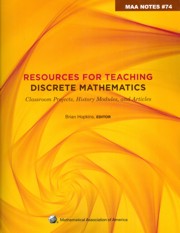Book contents
- Frontmatter
- Introduction
- Dedication
- Contents
- I Classroom-tested Projects
- The Game of “Take Away”
- Pile Splitting Problem: Introducing Strong Induction
- Generalizing Pascal: The Euler Triangles
- Coloring and Counting Rectangles on the Board
- Fun and Games with Squares and Planes
- Exploring Recursion with the Josephus Problem: (Or how to play “One Potato, Two Potato” for keeps)
- Using Trains to Model Recurrence Relations
- Codon Classes
- How to change coins, M&M's, or chicken nuggets: The linear Diophantine problem of Frobenius
- Calculator Activities for a Discrete Mathematics Course
- Bulgarian solitaire
- Can you make the geodesic dome?
- Exploring Polyhedra and Discovering Euler's Formula
- Further Explorations with the Towers of Hanoi
- The Two Color Theorem
- Counting Perfect Matchings and Benzenoids
- Exploring Data Compression via Binary Trees
- A Problem in Typography
- Graph Complexity
- II Historical Projects in Discrete Mathematics and Computer Science
- III Articles Extending Discrete Mathematics Content
- IV Articles on Discrete Mathematics Pedagogy
- About the Editor
The Game of “Take Away”
from I - Classroom-tested Projects
- Frontmatter
- Introduction
- Dedication
- Contents
- I Classroom-tested Projects
- The Game of “Take Away”
- Pile Splitting Problem: Introducing Strong Induction
- Generalizing Pascal: The Euler Triangles
- Coloring and Counting Rectangles on the Board
- Fun and Games with Squares and Planes
- Exploring Recursion with the Josephus Problem: (Or how to play “One Potato, Two Potato” for keeps)
- Using Trains to Model Recurrence Relations
- Codon Classes
- How to change coins, M&M's, or chicken nuggets: The linear Diophantine problem of Frobenius
- Calculator Activities for a Discrete Mathematics Course
- Bulgarian solitaire
- Can you make the geodesic dome?
- Exploring Polyhedra and Discovering Euler's Formula
- Further Explorations with the Towers of Hanoi
- The Two Color Theorem
- Counting Perfect Matchings and Benzenoids
- Exploring Data Compression via Binary Trees
- A Problem in Typography
- Graph Complexity
- II Historical Projects in Discrete Mathematics and Computer Science
- III Articles Extending Discrete Mathematics Content
- IV Articles on Discrete Mathematics Pedagogy
- About the Editor
Summary
Summary
In this project, students play the game “Take Away” and conceive a winning strategy for the game. They then must give a careful written explanation of why their strategies work. I typically use this project in my discrete math class as an introduction to writing proofs. Students often struggle initially with the clarity of their mathematical exposition and with aiming their proofs at an appropriate audience. After completing this activity, we have a class discussion where we critique the students' written explanations.
In most discrete math classes, students' first proofs involve properties of even and odd integers. Since these properties are already familiar to them, students often have trouble discerning what they can and cannot assume that the intended audience knows. Since the game “Take Away” is unfamiliar to most students, I find this project is a more natural starting point from which they begin thinking about the clarity of their own writing.
Alternately (or concurrently), this project could be used as an application of the division algorithm.
Notes for the instructor
Begin class by dividing the students into groups of three or four, and then pass out the worksheet. Allow one 50-minute class period to complete the worksheet, and have the students finish it at home if necessary.
Be sure to walk around the room and observe the groups as they are playing the game.
- Type
- Chapter
- Information
- Resources for Teaching Discrete MathematicsClassroom Projects, History Modules, and Articles, pp. 3 - 6Publisher: Mathematical Association of AmericaPrint publication year: 2009



